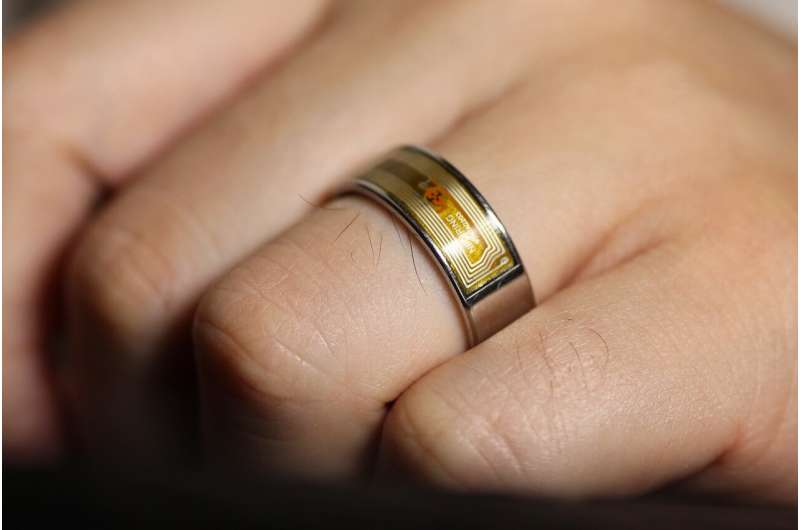This article has been reviewed according to Science X's editorial process and policies. Editors have highlighted the following attributes while ensuring the content's credibility:
fact-checked
trusted source
written by researcher(s)
proofread
Smart rings' ultra-precise movement tracking take wearable technology to the next level

There is a lot of hype about smart rings right now—Samsung is due to release a Galaxy ring, and there is unsubstantiated speculation that Apple is considering a ring too. But why would you want a smart ring in the first place?
The short answer is that they are likely to fulfill the same health and activity tracking as a watch, leaving your wrist free for a more fashionable or traditional timepiece.
But they can also track your body's movements much more precisely than other wearable technology, and record detailed information about the movement of your hands. This could allow you to control and interact with other technology in new ways—but also raise even more concerns about privacy.
The Oura ring has been available since 2015 and one of us, Max, has been wearing one for more than five years. He does this to track sleep and activity data during times when he does not want to wear a watch (including sleeping). These rings track changes in your body temperature, heart rate, heart rate variability (the time intervals between heart beats), blood oxygen levels, and physical activity. A smart watch can also do much of this.
It is expected that the Galaxy Ring will do the same (at least that is what one of their announcements focuses on), and be added to its health and fitness range.
Meanwhile, Apple's patent application indicates that its version may do more than monitor health. It may help control other devices, and vibrate to give users notifications.
Benefits all round?
Fingers are better than wrists at making specific gestures. With many more finger gesture options than arm positions, and finger gestures being the primary mode of interaction for VR (virtual reality) headsets, one probable future for smart rings is to control other devices. This would allow for the more precise detection of actions like pinching and pointing.
Multiple rings could work together to achieve this, with other devices. Apple's ring patent, for example, implies that rings could be worn in different bands along the length of a single finger (not an uncommon choice with normal rings), allowing a company to know how your finger is angled. If communicating with a watch, smart rings could detect finger and hand position in relation to your arm. This potentially provides more precise interactions with VR headsets.
In being able to carefully track fingers, rather than wrists, smart rings might allow technology companies to understand, model, and help improve many more activities, especially in situations where cameras and sensors are less likely to be found.
One example of this is learning to play classical guitar, which does not involve as much strumming with the whole arm or at the wrist, but where all the skill is in the fingers. Bringing sensors closer to the body's more dexterous touch sensors means that technology companies can more closely understand what you are doing.
Status symbols
Rings are jewelry, often worn to be seen. Apple is well known for making aesthetics a priority in its products. While the Galaxy ring looks a lot like the Oura Ring, it's likely that Apple will consider the importance of personalization and style.
Rings are not just worn on fingers, of course. Could rings for piercings, that go inside the body to some extent, like those on our ears or lips, give us additional data on ourselves?
There might also be value in incorporating smart technology into other adornments. There are already smart products designed to be worn as necklaces. Potentially necklaces could help monitor stress levels because stress is closely linked to breathing patterns. There has also been a smart bra.
Rings signify attachment
The most well-known association that a ring has is as a gift of commitment and attachment. Researchers have looked at how we can use digital technology to communicate with loved ones who are not physically present. Apple's smart ring patent includes haptic feedback (where technology applies forces or vibrations to the user to simulate the experience of touch).
Smart wedding rings could be used to transmit messages between partners—to let one of them know the other is thinking about them. For example, an interaction such as twisting the ring could make your partner's ring vibrate.
However, new smart devices will generate new forms of data and tracking, raising important questions about privacy and ethics. As with other wearable technology, there may be things people do not want to track. Imagine a message from your workplace telling you: "We see you aren't typing at your desk right now."
Social problems are also a possibility. If smart technology was incorporated into wedding rings, it could give people a way of tracking what their partners were doing even more closely than smartphones can.
These questions highlight the importance of governments focusing on the responsible use of AI, as well as responsible innovation. Research shows that over half of British people (52%) feel like they do not know how their personal data is being collected and used.
Companies could create more targeted advertising based on changing circumstances, as when someone learns they are pregnant. Some regions of the world even offer cheaper life insurance to people with better health data from wearables.
What we should ask is: what is responsible and irresponsible for companies to track and try to infer about people from their wearables? This question should be at the forefront of thinking in the big tech companies.
This article is republished from The Conversation under a Creative Commons license. Read the original article.![]()





















